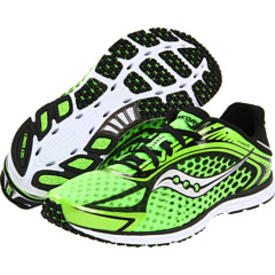Running: You are doing it wrong.
Replies
-
Interesting article! Thanks for posting. I will look into the book.0
-
This is a NYT article by Christopher McDougall from November 2011, about barefoot running and the 100up...
http://www.nytimes.com/2011/11/06/magazine/running-christopher-mcdougall.html?_r=10 -
This book was a great read! The whole minimalist running thing was intriguing, but so was the backstory being told about the giant race - read it!
After reading the book I bought into the minimalist idea and got some vibrams. It was a slow transition for me (as a long-time heel striker), but after a month or so, I noticed huge improvements in my 5k times. I can definitely see how people could get injured though if they try to jump into it too fast because it really is a totally different gait if you've been heel striking.
A few days ago I saw my first real "barefoot" runner in the city. I'm not sure how he did it because although we were in an area with relatively clean surfaces (no needles here!) it was about 40 degrees and that pavement must have been cold!0 -
Please be aware the research to support this claim is MINIMAL. The best research (I've seen only 1 actual academic study) made the following conclusions:
(1) Forefoot striking produces less chronic injury than heel strike running.
(2) Forefoot striking does NOT reduce the risk of severe injury.
(3) A change in running gait -- if not implemented slowly and carefully -- can produce injury. Some heel-toe runners would be best served to remain heel-toe runners.
All the claims that forefoot is "right" and all other gaits are "wrong" is NOT scientifically based. It's anecdotal at best and pushed by coaches and trainers whose data are not terribly rigorous.
The only scientific perspective is this: forefoot striking appears better in general, but this is not an absolute; transitioning can be a source of risk in and of itself.
A blog at the NY Times that discusses the research study in question (and interviews the authors of the study which looked at Harvard cross-country runners over several years) can be found at this link: http://well.blogs.nytimes.com/2012/02/08/why-runners-get-injured/?src=me&ref=general.
For the record, I'm a forefoot strike runner who has developed IT band issues during my transition. I think there is merit to adopting this running style if you can, but the evidence to claim one is right and the other is wrong (as advanced by the OP) simply does not exist at this time. Anecdotal evidence -- even collected from multiple sources -- does not qualify as a real scientific data set.
All I know is that prior to 1966 heel striking was UNCOMMON. Bill Bowerman renowned track and field coach for the Univ. of Oregon and Founder of Nike introduced it because he felt that by extending the leg further and planting yourself on the heel of your foot your stride length would be increased and you could cover more distance in a shorter time period and he designed the first Nike shoe to allow for a person to land on the heel by building up a soft cushion.
Book Excerpt----"His experiments left Bowerman with a debilitating nerve condition, but also the most cushioned running shoe ever created. In a stroke of dark irony, Bowerman named it the Cortez -- after the conquistador who plundered the New World for gold and unleashed a horrific smallpox epidemic.
Bowerman’s deftest move was advocating a new style of running that was only possible in his new style of shoe. The Cortez allowed people to run in a way no human safely could before: by landing on their bony heels."
So why wasn't anyone running that way before 1966? Because our shoes didn't allow for it. Ever worn a converse? Chuck Taylor's are quite popular again have you ever tried heel striking in a converse? Canvas shoe with a flat rubber sole.0 -
I am wondering how this relates to someone who jogs in place. I notice that my natural gait for this is to land on the ball of my foot and I barely lift my foot off the floor. I am pretty out of shape, and working on building some endurence.0
-
To me, its not about the shoe... that's not what the OP is saying. It's about form. It's a good article and if you are in a rut with your running, this could be a positive change. I have honestly not even noticed my running form, but I have been running a while now and I think I will start paying attention.
For me, I can't seem to break 9 min miles I get there, and fall back down to 10 min miles. It is driving me crazy. My goal is run a half then a full marathon. My farthest (recent) run has been 5 miles, anyone have any other suggestions? :-)
Exactly...I could care less about Vibrams or what shoe you wear...Wear a basketball shoe or a sandal I dont care. Its about the form and style of running. When you change how you do that you will see some amazing benefits. To the person who found a needle. I didn't tell you to run barefoot around needles... you have to use your head. Heck I didn't even tell you to run barefoot...I dont run barefoot.0 -
I have always been a mid-foot striker and I have a very short stride. I try hard to work on my cadence rather than my stride length. I am not a fast runner, but do feel like I'm and effective runner. My husband on the other hand, is a heel striker with a very long and graceful stride. He can wake up without any training and run a half marathon which he has done a couple of times. However, he always hurts after, even after the smallest of runs. He has hip and knee pain. I'm wondering if (in addition to lack of training) his form has something to do with that? Very interesting. Thanks for posting.
By the way, my husband is 6'1" very lean and toned and I am 5'3" very stalky and chunky We make terrible running partners! 0
We make terrible running partners! 0 -
I have been intrigued by minimalist and barefoot running stories. I have read the book and I have friends that attribute their injury free training to minimalist shoes. I tend to strike mid-foot. I am in a neutral running shoe now (Saucony Pro Grid Ride) and I would like to transition into a minimlaist shoe. I am 5'6" and 140 lbs. I run regularly. Any suggestions on a shoe to try? Thanks!0
-
Are you actually running barefoot outside on sidewalks or say, along a beach or grassy areas? I'm curious because it sounds kind of painful!
I ran on sidewalks, and it was not painful at all! Out feet are actually bouncy and elastic, with a complex energy storage structure in the arch, but since we wear shoes we never experience that feeling. Running on a very hard, smooth surface is amazingly comfortable, because your foot uses the elastic tendons like bouncy springs. It's much more comfortable than soft surfaces. Your feet know what to do. it's amazing.0 -
The running shoe manufacturers are doing everyone a disservice. They are attacking the problem the wrong way and causing more problems. Instead of runners being encouraged to run with proper form, instead they are being encouraged to buy creatively designed shoes to minimize the injury risk while continuing to run improperly. Not only that, but these shoes aren't even proven to do what they claim to do.
I am not sold on running high volume in Vibrams or barefoot on pavement, but I do find barefoot running to be an extremely valuable tool to helping one develop proper form. But when it comes to high volume on pavement, I will say its safe to run in lightweight racing shoes with relatively thin soles. My shoes are about 7 oz, and I ignore the advice that I should be running in thick training shoes and saving the racing shoes for race day. Sounds like rubbish to get me to buy more shoes.0 -
bump0
-
This is interesting and something my sister has told me about before. I tried forefoot running once but found it quite painful and harder in general than 'heel striking'.
What are the actual advantages to forefoot running other than reducing the risk of injury?0 -
HMMMMM, I wonder if I'm a natural runner because that's the way I've always run. I remember in gym class my teacher telling me I wasn't running correctly. On the rare occasion when I've run as an adult, eg: after the ice cream truck, I still run that way or if I'm crossing the street and the light is about to change. Thanks for posting this, going to get the book and possibly start running.0
-
Bump0
-
Love it! Thanks for the post.
I've actually been wanting to get into barefoot running. As soon as I can afford some minimalist/barefoot shoes, I will buy some. Until then, I will work on my form. I already kind of run that way, though.0 -
Bump.0
-
I was wondering about this. i have heard of barefoot running, but unsure of it. Thanks for sharing the info.0
-
BringUpMyPost0
-
Interesting...a friend of mine has been espousing this book and running style for a while now. I've been building up to my first 5k, but recently got both a stiff back and sore knees, and am wondering if running on pavement has played a part in these. I didn't see anything specific about running causing these symptoms but will give this a try and see if it helps or reduces those!0
-
Does anyone know how barefoot running affects runners with fallen arches and perpetual IT problems and hip pain? I would love to know if anyone has found it has helped. I would do anything to not have to wear my orthotics everywhere I go.
The book talks about how shoes maybe the cause of fallen/weak arches...It might be something you should look into. Also maybe finding some exercises to strengthen your foot and specifically your arch.0 -
bump0
-
bump0
-
Interesting...a friend of mine has been espousing this book and running style for a while now. I've been building up to my first 5k, but recently got both a stiff back and sore knees, and am wondering if running on pavement has played a part in these. I didn't see anything specific about running causing these symptoms but will give this a try and see if it helps or reduces those!This is interesting and something my sister has told me about before. I tried forefoot running once but found it quite painful and harder in general than 'heel striking'.
What are the actual advantages to forefoot running other than reducing the risk of injury?
When you run with your mid/fore foot and keep your hips and legs beneath you it tends to cause you to absorb the impact in your legs and the bend of your knee rather then in your hips causing your strike to become softer and less harsh. Its more of a softer gait then hard pounding. I can tell you after I transitioned to a mid/fore foot strike, Note: I still wear shoes, I broke sub 30 min 5K times that I had been bumping against for months. Also I tend to settle in and get comfortable running and just let my legs go until I'm done now. Its made the whole of running a lot more enjoyable.0 -
bmp0
-
This is interesting and something my sister has told me about before. I tried forefoot running once but found it quite painful and harder in general than 'heel striking'.
What are the actual advantages to forefoot running other than reducing the risk of injury?
Its not something that happens overnight. You need to condition your feet to run that way and undo years of foot weakening (due to wearing shoes all the time). I used to be a heel-striker and switched to mid-foot. It took me about 2 months to build up to where I could run my normal volume exclusively landing mid-foot because my calves would get very sore while I was adapting. If you want to change your form, you need to start out doing it in small increments and gradually increase the duration until its comfortable and natural to you.
If you run short strides with mid-foot striking its also more economical, in addition to reducing the risk of injury.0 -
This is a great post! Thank you so much!0
-
Bump :-)0
-
This is a NYT article by Christopher McDougall from November 2011, about barefoot running and the 100up...
http://www.nytimes.com/2011/11/06/magazine/running-christopher-mcdougall.html?_r=1
Fantastic Article
Love this quote..."But simply putting something different on your feet doesn’t make you a gliding Tarahumara. The “one best way” isn’t about footwear. It’s about form. Learn to run gently, and you can wear anything. Fail to do so, and no shoe — or lack of shoe — will make a difference."0 -
bump0
-
Bumping to read later0
This discussion has been closed.
Categories
- All Categories
- 1.4M Health, Wellness and Goals
- 398.2K Introduce Yourself
- 44.7K Getting Started
- 261K Health and Weight Loss
- 176.4K Food and Nutrition
- 47.7K Recipes
- 233K Fitness and Exercise
- 462 Sleep, Mindfulness and Overall Wellness
- 6.5K Goal: Maintaining Weight
- 8.7K Goal: Gaining Weight and Body Building
- 153.5K Motivation and Support
- 8.4K Challenges
- 1.4K Debate Club
- 96.5K Chit-Chat
- 2.6K Fun and Games
- 4.7K MyFitnessPal Information
- 17 News and Announcements
- 21 MyFitnessPal Academy
- 1.5K Feature Suggestions and Ideas
- 3.2K MyFitnessPal Tech Support Questions























